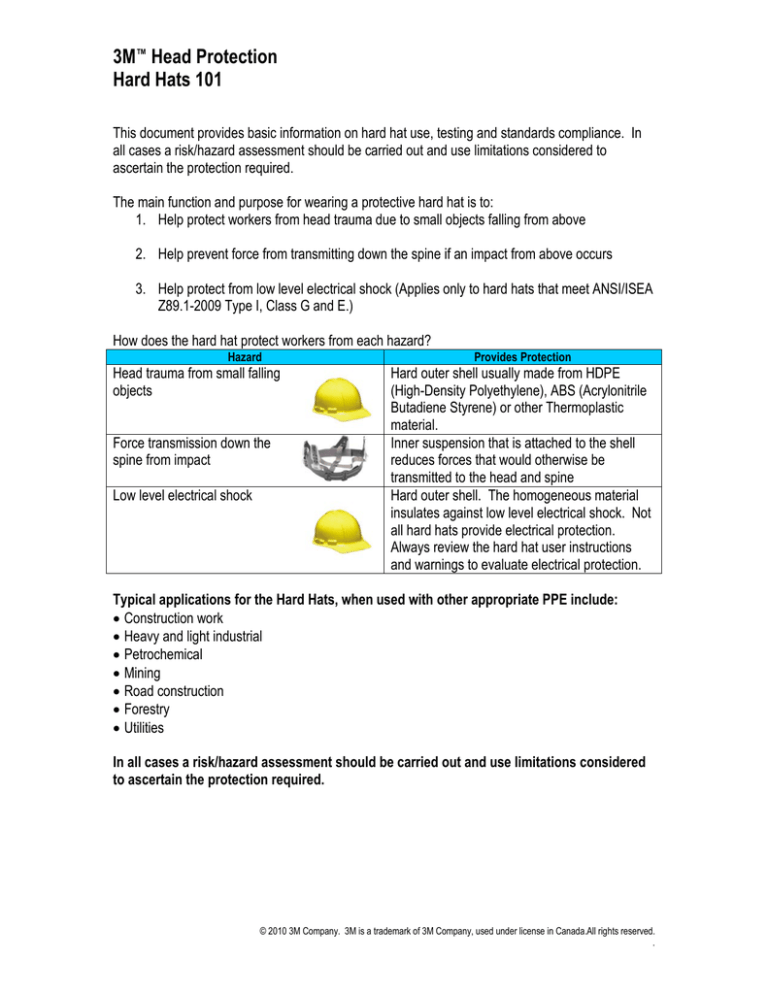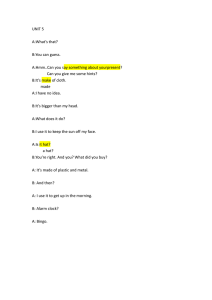
3M™ Head Protection
Hard Hats 101
This document provides basic information on hard hat use, testing and standards compliance. In
all cases a risk/hazard assessment should be carried out and use limitations considered to
ascertain the protection required.
The main function and purpose for wearing a protective hard hat is to:
1. Help protect workers from head trauma due to small objects falling from above
2. Help prevent force from transmitting down the spine if an impact from above occurs
3. Help protect from low level electrical shock (Applies only to hard hats that meet ANSI/ISEA
Z89.1-2009 Type I, Class G and E.)
How does the hard hat protect workers from each hazard?
Hazard
Head trauma from small falling
objects
Force transmission down the
spine from impact
Low level electrical shock
Provides Protection
Hard outer shell usually made from HDPE
(High-Density Polyethylene), ABS (Acrylonitrile
Butadiene Styrene) or other Thermoplastic
material.
Inner suspension that is attached to the shell
reduces forces that would otherwise be
transmitted to the head and spine
Hard outer shell. The homogeneous material
insulates against low level electrical shock. Not
all hard hats provide electrical protection.
Always review the hard hat user instructions
and warnings to evaluate electrical protection.
Typical applications for the Hard Hats, when used with other appropriate PPE include:
• Construction work
• Heavy and light industrial
• Petrochemical
• Mining
• Road construction
• Forestry
• Utilities
In all cases a risk/hazard assessment should be carried out and use limitations considered
to ascertain the protection required.
© 2010 3M Company. 3M is a trademark of 3M Company, used under license in Canada.All rights reserved.
.
3M™ Head Protection
Hard Hats 101
Page 2 of 6
Compliance Standards
Overview
Impact Type
ANSI/ISEA Z89.1-2009
Establishes the minimum performance requirements for protective
helmets that reduce the forces of impact and penetration and that may
provide protection from electrical shock.
–
–
Electrical Classes
–
–
–
Type I: Intended to reduce force of impact from blow to top of the
head
Type II: Intended to reduce force of impact from blow to top or
sides of the head
Class C (Conductive)
– Not intended to provide protection against contact with
electrical hazards
Class G (General)
– Reduce the danger of contact with low voltage conductors
– Proof-tested at 2,200 volts
Class E (Electrical)
– Reduce the danger of contact with higher voltage
conductors
– Proof-tested at 20,000 volts
Test
Force Transmission
Compliance to the ANSI/ISEA Z89.1 Standard means…
Helmets shall not transmit a force to the test head form that exceeds
4450 N (1000 lbs). Maximum transmitted force of each individual test
sample shall be averaged. The averaged values shall not exceed
3780 N (850 lbs).
Apex Penetration
The penetrator shall not make contact with the top of the head form.
Flammability
No flame shall be visible 5 seconds after removal of the test flame.
Class C
Class C helmets are not tested for electrical insulation.
Class G (Electrical)
Shall withstand 2200 volts (root mean square), AC, 60 Hertz, for 1
minute. Leakage shall not exceed 3 milliamperes.
Class E (Electrical)
Must first pass the Force Transmission Test. Shall withstand 20,000
volts (root mean square), AC, 60 Hertz, for 3 minutes. Leakage shall
not exceed 9 milliamperes. At 30,000 volts, the test sample shall not
burn through.
© 2010 3M Company. All rights reserved. 3M is a trademark of 3M Company, used under license in Canada.
3M™ Head Protection
Hard Hats 101
Test Type
Force Transmission
(Individual tests / Average)
Page 3 of 6
•
•
•
•
Apex Penetration
(Pass / Fail)
•
•
•
•
Flammability
(Pass / Fail)
•
•
•
•
Summary of ANSI/ISEA Hard Hat Testing Guidelines
Impactor shall have a mass of 8 lbs.
Striking face of impactor shall be spherical with radius of 1.9
inches
Impactor shall remain rigid upon impact
Impactor shall be dropped from a height that yields an impact
velocity of 18 ft/s. (12.2 mph)
Penetrator shall have a mass of 2.2 lbs., with a steel tip, a 60
degree included angle and a spherical tip radius of 0.010
inches.
Penetrator shall remain rigid upon impact.
Penetrator shall be guided and electrically insulated from
metal head form.
Penetrator shall be dropped from a height that yields an
impact velocity of 23 ft/s (15.7 mph)
Bunsen burner is adjusted to produce a 2.0 inch blue flame
with an inner cone of 1.0 inch.
The temperature of the flame at the tip of the inner cone shall
be 1472 – 1652 degrees F.
The flame shall be applied so the inner cone is within 0.08
inches from the helmet surface. The flame is applied for 5
seconds.
The sample is inspected for any visible flame, 5 seconds after
removal of the test flame.
ANSI/ISEA Z89.1-2009 Test Guidelines
• Total number of hats for protocol: 30
• All testing shall be performed at room temperature (73.4°F, 23°C)
• “Hot” test samples shall be placed in forced air circulating oven maintained at 120°F
(48.4°C) for at least two hours.
• “Cold” test samples shall be placed in an environmental chamber maintained at 0°F
(17.7° C) for at least two hours.
• “Low Temp” test samples shall be placed in an environmental chamber maintained at
a temperature of -22°F (-30°C) for at least four hours.
• All hot, cold and low-temp samples shall be tested for impact and penetration within 30
seconds after removal from the conditioned environment.
© 2010 3M Company. All rights reserved. 3M is a trademark of 3M Company, used under license in Canada.
3M™ Head Protection
Hard Hats 101
Page 4 of 6
Optional Testing Requirements for ANSI/ISEA Z89.1-2009
Requirement
Reverse Wearing
Low Temperature
High-Visibility
Test
Pass the force transmission test when mounted in the
reveres position on the test head form.
Test samples placed in environmental chamber
maintained at -22°F (-30°C) for at least four hours and
then tested to the impact and penetration test
requirements.
Hard hat demonstrates chromaticity that lies within one
of the areas defined within Table 1 of the ANSI/ISEA
Z89.1-2009 standard. (Fluorescent yellow-green,
Fluorescent orange-red, Fluorescent red)
Designation on
Warning Label
LT
HV
Replacement Recommendations
Hard hat should be immediately replaced if subjected to impact. 3M recommends the wearer
replace the hard hat suspension at least every twelve months and the hard hat shell at least every
two to five years depending on work environment. Inspect the hard hat, including the suspension
and shell, prior to each use. Replace at first sign of wear. Refer to user instructions for proper
installation and replacement of the suspension.
Hard Hat Inspection
A hard hat shell should be inspected prior to each use. Immediately replace the hard hat if any sign
of wear appears or if there is any evidence of damage, abuse or plastic degradation as this may be
a sign that protection is reduced. Any hard hat that shows signs of worn or damaged parts should
be removed from service immediately and replaced.
Workers in environments with higher levels of exposure to sunlight, heat, cold or chemicals should
replace their hard hats more frequently than workers in other environments. If the hard hat shell
becomes faded in color, exhibits a chalky appearance, or feels stiff and brittle, degradation of the
shell may be occurring. A hard hat should be replaced immediately at the first sign of any of these
conditions.
Hard hat suspensions should also be inspected closely for cracks, frayed straps or other signs of
wear. Any suspension that is damaged must be removed from service and replaced immediately.
It is recommended to replace the entire suspension system at least every 12 months.
Maintenance and Storage
Clean the hard hat and suspension with mild soap and water. Rinse and wipe dry. Do not use
paints, solvents, chemicals, adhesives, gasoline or like substances on this hard hat. Store the hard
hat away from direct sunlight.
© 2010 3M Company. All rights reserved. 3M is a trademark of 3M Company, used under license in Canada.
3M™ Head Protection
Hard Hats 101
Page 5 of 6
Frequently Asked Questions
Q. When should head protection be provided to workers?
A. When there is potential for:
1) Objects to fall from above
2) Contact with fixed objects (exposed beams, pipes, etc.)
3) Contact with exposed electrical conductors
Q. How does a hard hat protect the worker?
A. It helps protect workers in the following ways:
1) Resists and deflects blows to the head
2) Reduces shock to protect the neck and spine
3) Can insulate against electrical shock (Applies only to hard hats that meet ANSI/ISEA
Z89.1-2009 Type I, Class G and E.)
Q. Is a hard hat compliant if worn backwards by the worker?
A. Only if the hard hat was tested to the standard with the suspension in the reverse position and
the hard hat is marked with the "reverse donning" symbol.
Q. What factors can damage a hard hat?
A. All of the following:
1) Impact to the hard hat
2) UV exposure
3) Chemical exposure
4) Abuse
Q. How often should a hard hat be replaced?
A. Under any of the following circumstances:
1) Immediately if a blow to the hard hat occurs.
2) Shell – Recommended to replace every 2 – 5 years dependant on environment and use
3) Suspension – Recommended to replace at least every 12 months dependant on
environment and use
There is currently no official standard or regulatory requirement for replacing a hard hat or
suspension – only recommendations.
Additional Hard Hat Warnings:
• Hard hats are designed to provide limited head protection from small falling objects striking the
top of the hard hat.
• Type 1 hard hats are not designed to provide front, side or rear impact protection.
• In order to provide maximum protection, the hard hat must fit securely on the head and the
suspension must be adjusted to a snug fit.
• Never alter, puncture, modify or engrave the shell or the suspension of a hard hat.
© 2010 3M Company. All rights reserved. 3M is a trademark of 3M Company, used under license in Canada.
3M™ Head Protection
Hard Hats 101
Page 6 of 6
• Inspect your hard hat shell and suspension frequently. Check for cracks, frayed straps and any
sign of damage before every use. Replace the hard hat immediately if you notice any signs of
wear, damage, abuse or degradation.
• If the hard hat has sustained an impact, dispose of it immediately, even if damage is not visible.
• Prolonged exposure to direct sunlight will degrade the hard hat shell. Do not store in direct
sunlight when not in use.
• Do not use paints, solvents, chemicals, adhesives, gasoline or like substances on this hard hat.
These materials can cause deterioration to the shell’s ability to withstand impact and penetration.
• Do not store objects between the suspension and the shell of a hard hat.
For More Information:
Technical Assistance 1-800-243-4630
Customer Care Center 1-800-328-1667
Internet
3M.com/OccSafety
WARNING!
3M™ Hard Hats provide limited protection only. Misuse or
failure to follow warnings and User Instructions may
result in serious personal injury or death. For proper
use, see supervisor, User Instructions, or call 3M
Occupational Health and Environmental Safety Division
(OH&ESD) Technical Assistance.
© 2010 3M Company. All rights reserved. 3M is a trademark of 3M Company, used under license in Canada.





